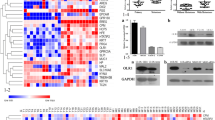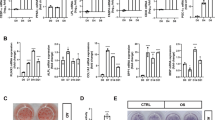Abstract
Purpose
Bone metastasis is the result of complex crosstalk between tumor cells and bone marrow cells. Bone marrow adipocytes (BMAs) are the most abundant cell type in adult bone marrow. Therefore, we explore the effects of BMAs on bone metastasis in lung cancer.
Methods
RNA-seq was used to compare the mRNA expression level of bone metastatic SBC5 cells and non-bone metastatic SBC3 cells. Rosiglitazone-induced marrow adiposity and intra-femoral injection of SBC5 cells were used to demonstrate the relationship between BMAs and SBC5 cells in vivo. Co-culture system, gene co-expression, gene ontology (GO) enrichment analysis and protein–protein interaction (PPI) network were used to explore the potential mechanism.
Results
BMAs specially enhance the invasion of bone metastatic SBC5 instead of non-bone metastatic SBC3 in vitro. SBC5 instead of SBC3 promoted osteoblast and osteoclast differentiation as well as de-differentiation of mature BMAs. Rosiglitazone-induced marrow adiposity significantly enhanced osteolytic lesion induced by SBC5 in vivo. RNA-seq revealed that compared with SBC3, S100A9 and S100A8 genes were the most prominent genes up-regulated in SBC5 cells. High expression of S100A8/9 in SBC5 could be responsible for the crosstalk between lung cancer cells and BMAs. More importantly, interleukin 6 receptor (IL6R), which is adjacent to S100A8/A9 in 1q21.3, was significantly up-regulated by BMAs in vitro. S100A8/A9 (1 μg/ml) could obviously enhance the osteoblastic differentiation and inhibit adipogenic differentiation, whereas TLR4 inhibitor TAK242 (10 μmol/l) significantly attenuated this effect.
Conclusions
Our study suggested that bone marrow adipocyte may communicate with lung cancer cells via 1q21.3 (S100A8/A9-IL6R)-TLR4 pathway to promote osteolytic bone destruction. 1q21.3 (S100A8/A9-IL6R) is a potential target for the treatment of lung cancer bone metastasis.






Similar content being viewed by others
References
Arai K et al (2001) Immunohistochemical investigation of S100A9 expression in pulmonary adenocarcinoma: S100A9 expression is associated with tumor differentiation. Oncol Rep 8(3):591–596
Behan JW et al (2009) Adipocytes impair leukemia treatment in mice. Cancer Res 69(19):7867–7874. https://doi.org/10.1158/0008-5472.CAN-09-0800
Brunetti G et al (2020) LIGHT/TNFSF14 promotes osteolytic bone metastases in non-small cell lung cancer patients. J Bone Miner Res 35(4):671–680. https://doi.org/10.1002/jbmr.3942
Bullwinkle EM et al (2016) Adipocytes contribute to the growth and progression of multiple myeloma: unraveling obesity related differences in adipocyte signaling. Cancer Lett 380(1):114–121. https://doi.org/10.1016/j.canlet.2016.06.010
De S et al (2010) Genomic neighbourhood and the regulation of gene expression. Curr Opin Cell Biol 22(3):326–333. https://doi.org/10.1016/j.ceb.2010.04.004
D'Oronzo S et al (2019) Metastatic bone disease: pathogenesis and therapeutic options: up-date on bone metastasis management. J Bone Oncol 15:4. https://doi.org/10.1016/j.jbo.2018.10.004
Ehsanipour EA et al (2013) Adipocytes cause leukemia cell resistance to l-asparaginase via release of glutamine. Cancer Res 73(10):2998–3006. https://doi.org/10.1158/0008-5472.CAN-12-4402
Engblom C et al (2017) Osteoblasts remotely supply lung tumors with cancer-promoting SiglecF(high) neutrophils. Science. https://doi.org/10.1126/science.aal5081
Fidler IJ et al (2008) The "seed and soil" hypothesis revisited. Lancet Oncol 9(8):808. https://doi.org/10.1016/S1470-2045(08)70201-8
Gandaglia G et al (2015) Impact of the site of metastases on survival in patients with metastatic prostate cancer. Eur Urol 68(2):325–334. https://doi.org/10.1016/j.eururo.2014.07.020
Gimble JM et al (1996) The function of adipocytes in the bone marrow stroma: an update. Bone 19(5):421–428
Goh JY et al (2017) Chromosome 1q213 amplification is a trackable biomarker and actionable target for breast cancer recurrence. Nat Med 23(11):1319–1330. https://doi.org/10.1038/nm.4405
He X et al (2016) TLR4 Activation Promotes Bone Marrow MSC Proliferation and Osteogenic Differentiation via Wnt3a and Wnt5a Signaling. PLoS ONE 11(3):e149876. https://doi.org/10.1371/journal.pone.0149876
Herroon MK et al (2013) Bone marrow adipocytes promote tumor growth in bone via FABP4-dependent mechanisms. Oncotarget 4(11):2108–2123. https://doi.org/10.18632/oncotarget.1482
Hirata T et al (2016) Specific bone region localization of osteolytic versus osteoblastic lesions in a patient-derived xenograft model of bone metastatic prostate cancer. Asian J Urol 3(4):229–239. https://doi.org/10.1016/j.ajur.2016.09.001
Hiratsuka S et al (2006) Tumour-mediated upregulation of chemoattractants and recruitment of myeloid cells predetermines lung metastasis. Nat Cell Biol 8(12):1369–1375. https://doi.org/10.1038/ncb1507
Kraus NA et al (2016) Quantitative assessment of adipocyte differentiation in cell culture. Adipocyte 5(4):351–358. https://doi.org/10.1080/21623945.2016.1240137
Lazarenko OP et al (2007) Rosiglitazone induces decreases in bone mass and strength that are reminiscent of aged bone. Endocrinology 148(6):2669–2680. https://doi.org/10.1210/en.2006-1587
Leslie K et al (2010) Differential interleukin-6/Stat3 signaling as a function of cellular context mediates Ras-induced transformation. Breast Cancer Res 12(5):R80. https://doi.org/10.1186/bcr2725
Luo G et al (2018) Bone marrow adipocyte: an intimate partner with tumor cells in bone metastasis. Front Endocrinol (Lausanne) 9:339. https://doi.org/10.3389/fendo.2018.00339
Marchesini M et al (2017) ILF2 is a regulator of RNA splicing and DNA damage response in 1q21-amplified multiple myeloma. Cancer Cell 32(1):88–100. https://doi.org/10.1016/j.ccell.2017.05.011
Miki T et al (2000) Bone metastasis model with multiorgan dissemination of human small-cell lung cancer (SBC-5) cells in natural killer cell-depleted SCID mice. Oncol Res 12(5):209–217. https://doi.org/10.3727/096504001108747701
Nacken W et al (2003) S100A9/S100A8: Myeloid representatives of the S100 protein family as prominent players in innate immunity. Microsc Res Tech 60(6):569–580. https://doi.org/10.1002/jemt.10299
Niikura N et al (2011) Treatment outcome and prognostic factors for patients with bone-only metastases of breast cancer: a single-institution retrospective analysis. Oncologist 16(2):155–164. https://doi.org/10.1634/theoncologist.2010-0350
Riihimaki M et al (2014) Metastatic sites and survival in lung cancer. Lung Cancer 86(1):78–84. https://doi.org/10.1016/j.lungcan.2014.07.020
Scheller EL et al (2014) Use of osmium tetroxide staining with microcomputerized tomography to visualize and quantify bone marrow adipose tissue in vivo. Methods Enzymol 537:123–139. https://doi.org/10.1016/B978-0-12-411619-1.00007-0
Shafat MS et al (2017) Leukemic blasts program bone marrow adipocytes to generate a protumoral microenvironment. Blood 129(10):1320–1332. https://doi.org/10.1182/blood-2016-08-734798
Sheng X et al (2016) Adipocytes cause leukemia cell resistance to daunorubicin via oxidative stress response. Oncotarget 7(45):73147–73159. https://doi.org/10.18632/oncotarget.12246
Szczerba BM et al (2019) Neutrophils escort circulating tumour cells to enable cell cycle progression. Nature. https://doi.org/10.1038/s41586-019-0915-y
Tabe Y et al (2017) Bone marrow adipocytes facilitate fatty acid oxidation activating AMPK and a transcriptional network supporting survival of acute monocytic leukemia cells. Cancer Res 77(6):1453–1464. https://doi.org/10.1158/0008-5472.CAN-16-1645
Takeuchi O et al (1999) Differential roles of TLR2 and TLR4 in recognition of gram-negative and gram-positive bacterial cell wall components. Immunity 11(4):443–451
Trotter TN et al (2016) Adipocyte-lineage cells support growth and dissemination of multiple myeloma in bone. Am J Pathol 186(11):3054–3063. https://doi.org/10.1016/j.ajpath.2016.07.012
Wolins NE et al (2006) OP9 mouse stromal cells rapidly differentiate into adipocytes: characterization of a useful new model of adipogenesis. J Lipid Res 47(2):450–460. https://doi.org/10.1194/jlr.D500037-JLR200
Yamaguchi T et al (1996) Intertrabecular pattern of tumors metastatic to bone. Cancer 78(7):1388–1394. https://doi.org/10.1002/(SICI)1097-0142(19,961,001)78:7<1388:AID-CNCR4>3.0.CO;2-H
Yamaguchi T (2001) Intertrabecular vertebral metastases: metastases only detectable on MR imaging. Semin Musculoskelet Radiol 5(2):171–175. https://doi.org/10.1055/s-2001-15,676
Acknowledgements
We thank the research core facility of west china hospital at Sichuan university for assistance with histopathology.
Funding
This work was supported by grants from the National Natural Science Foundation of China (nos. 81770875, 81572639), the Science and Technology Department of Sichuan Province (2018SZ0142), the Sichuan University (no. 2018SCUH0093), and the National Clinical Research Center for Geriatrics of West China Hospital (no. Z2018B05), 1.3.5 project for disciplines of excellence, West China Hospital, Sichuan University (2020HXFH008, ZYGD18022).
Author information
Authors and Affiliations
Contributions
GL and MT: methodology, investigation, formal analysis, writing—original draft preparation; QZ, LL, YL, YX and CL: methodology, investigation, data curation, formal analysis; LT and XC: writing—original draft preparation, methodology, visualization; XY: conceptualization, writing—original draft preparation, writing—review and editing, visualization, supervision, project administration, funding acquisition. GL and MT contributed equally to this article.
Corresponding author
Ethics declarations
Conflict of interest
The authors declare that they have no competing interests.
Ethical approval
All procedures were approved by the Institutional Animal Care and Use Committee of West China Hospital, Sichuan University.
Additional information
Publisher's Note
Springer Nature remains neutral with regard to jurisdictional claims in published maps and institutional affiliations.
Electronic supplementary material
Below is the link to the electronic supplementary material.
Rights and permissions
About this article
Cite this article
Luo, G., Tang, M., Zhao, Q. et al. Bone marrow adipocytes enhance osteolytic bone destruction by activating 1q21.3(S100A7/8/9-IL6R)-TLR4 pathway in lung cancer. J Cancer Res Clin Oncol 146, 2241–2253 (2020). https://doi.org/10.1007/s00432-020-03277-9
Received:
Accepted:
Published:
Issue Date:
DOI: https://doi.org/10.1007/s00432-020-03277-9




